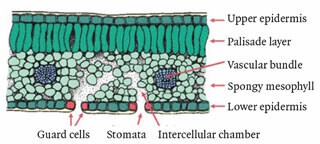The botany student’s textbook leaf, in anatomical cross-section, is a sandwich with two thick fillings packaged between thin outer envelopes. The outer layers – upper and lower epidermis – are each usually a single layer of cells, coated with a waxy hydrophobic cuticle. The fillings – the mesophyll – have an upper rank of vertically-oriented palisade cells, packed with chloroplasts that are the seat of photosynthesis; and a lower rank of more loosely packed cells – the spongy mesophyll – with large intercellular spaces through which water and gases diffuse between the plant tissues and the surrounding air. Gases enter and exit the leaf via small pores – the stomata – in the lower epidermis; these can open and close according to the weather and the availability of water. The whole structure is supported (and supplied with water and nutrients) by a network of veins – the vascular system – that permeates the leaf and connects them to the stem and ultimately the roots.
There are variations on this anatomical theme, but it is quite consistent across the plant kingdom. Slice through any leaf and look at it under the microscope and you will see this recognisable basic pattern, with variations in the thickness of the various layers, and in the relative sizes and dispositions of the cells. At the scale of the whole leaf, though, the variety is huge. For a start, leaves range in size over three orders of magnitude. They have a wondrous multiplicity of shapes. Some are ‘simple’ (with a single blade); others are ‘compound’ (with multiple blades), as in ash trees or ferns. Leaf veins come in all kinds of reticulated patterns. Leaf margins can be smooth and simple, or lobed or toothed. Leaf surfaces can be rough or smooth, hairy, spiny or naked. Why? Thirty-five years ago, in The Encyclopedia of Ignorance, Peter Grubb posed questions about the sizes and shapes and function of leaves: why most evergreen leaves are oblong or ovate, in contrast to the leaves of deciduous species, which have a much wider variety of shapes; why leaves two hundred million years ago had a range of shapes different from modern leaves; why tropical climbers often have heart-shaped leaves; why tropical leaves often have ‘drip-tips’ – extended tips at their distal points – and why many tropical trees have juvenile leaves that are limp and hanging, and often brightly coloured. At a finer anatomical level, Grubb asked why the internal tissue of a leaf is divided into palisade and spongy mesophyll; why the outermost layers of cells are mostly colourless and hence useless for photosynthesis; and why there is variation in the size, frequency and distribution of the stomata. Back at the coarser level, he asked how leaves respond to distortion by wind and drought; and pointed out how little we know about the adaptive processes that make it possible for leaves to adjust their own disposition, such as the ‘sleep movements’ seen in the leaflets of many tropical trees.
The morphology, anatomy and variety of leaves have been exhaustively documented by botanists over the centuries. Linnaeus, the self-styled father of modern botany, listed more than sixty different types of simple leaf (i.e. leaves not divided into separate leaflets – or compound leaves – of which he distinguished a mere 18 types), all with their appropriate terminology. For example, ‘ovate’ describes the typical leaf with a tip that is rather more (but not much more) elongated than its rounded base; lanceolate and linear leaves are long and slender; dentate and serrated leaves have toothed or saw-like margins; pilose and tomentose leaves have different degrees of hairiness. There are specific terminologies for the shapes of the tips and the bases of leaves, and their margins. All of this is useful when identifying and distinguishing different species of plants (though nothing like as reliable and accurate as the terminology for flowers, especially when establishing relationships between species), but is almost useless for relating structure to function except in the most general way. Some types of hairy leaf can be shown to deter herbivores, or smaller, thicker leaves can be shown to be more efficient in the upper canopy than in the shaded understorey of the forest, but what might be the functional significance of a heart-shaped leaf base or a rounded leaf tip? A leaf is a leaf: it has one thing to do (photosynthesis, the elaborate mechanism by which carbohydrate is produced from carbon dioxide and water using sunlight as fuel) and a few things to avoid (getting eaten or infected), so why is it manifest in so many different forms and guises?
The answers, as one can begin to infer from Steven Vogel’s book, lie in the interplay of evolution and physics. A leaf is a fine exemplar of the challenges posed by the physical world to the biological, because it’s on the front line. Unlike an animal, a leaf is absolutely stuck with its lot: it cannot seek shade when the sun gets too hot, it cannot go in search of water when the rains don’t come; it cannot run away from predators. Physics, herbivores and pathogens have set the boundaries within which leaf-form can evolve, and evolution has inexorably ensured that just about every imaginable avenue within those constraints has been thoroughly explored. Two factors have been indispensable in making possible the evolutionary proliferation of multiple shapes and forms in living organisms. One of these is the occupation of a 3D environment; the other is multicellularity, which allows an organism the possibility of taking almost any shape. For a couple of billion years before life on dry land took hold, living organisms seem to have developed and diversified entirely unicellularly, and mostly in water or regularly wetted habitats like the intertidal zone. By the time the first tentative steps were taken to colonise the permanently exposed surface of the land, virtually all the metabolic processes that characterise life were in place, having evolved in the relatively (but not entirely) equable aqueous environments of oceans, wetlands, lakes and rivers. Pre-eminent among these biochemical processes was photosynthesis, which to a first approximation has sustained all life on Earth, directly or indirectly, ever since.
Reading The Life of a Leaf, one is tempted to wonder why dry land was colonised at all, let alone why the colonisers continued to evolve into the wide array of forms – extant and extinct – that have covered the Earth’s surface since. Earth has been described as a goldilocks planet, where conditions are not too cold and not too hot but just right for life (the hunt has been on for planets in other solar systems where conditions might be similar). But, ‘just right’ doesn’t necessarily mean benign, and evolution has had to work within some fairly tight constraints. The purely physical challenges on land are much more numerous and daunting than in water. Ambient temperatures are far more variable, not just seasonally (away from the tropics), but daily, hourly or even on the scale of minutes and seconds (sudden exposure to direct sunlight as cloud cover clears or sunflecks move across the forest understorey can cause equally sudden increases in leaf temperature). Humidity goes up and down. The water supply is erratic. And, once a plant starts to hoist bits of itself skyward, structural and mechanical challenges exert themselves in the form of gravity and wind. A leaf has to spread itself out as thinly and – especially when in relative shade – as horizontally as possible to maximise light interception, yet this imposes significant structural difficulties. And when all these problems have been solved, there are biological challenges too: the leaf has to cope with herbivores and pathogens: with all this vital tissue spread out so thinly, the immobile leaf is uniquely vulnerable.
But plants and their leaves have met these challenges, and Vogel explains how they have done it – not by giving a chronological evolutionary account, but by focusing on the attributes of an everyday leaf. For example, avoiding overheating is one of the more obvious problems a leaf has to solve. When the wind isn’t blowing, the temperature of a sunlit leaf can exceed that of the surrounding air by 20°C, which is much higher than the optimum temperature for efficient photosynthesis. In any case, full sunlight is far more intense and bright than is necessary to maximise the rate of photosynthesis, so many of a leaf’s adaptations are directed towards mitigating rather than harvesting the effects of sunlight. There are three principal means by which a leaf manages this: re-radiation, whereby absorbed energy is offloaded as the leaf heats up; evaporation, by which energy is removed from the leaf as water on its surface turns to vapour; and convection, the transfer of heat to the air moving across the leaf’s surface. Leaves display adaptations that exploit these possibilities as best they can. Smaller, deeply lobed leaves are better at keeping relatively cool, because heat at the leaf’s centre can reach and dissipate more easily from the edges; and in some tree species a range of leaf shapes may be found on different parts of the plant, according to their exposure to the sun (and hence, incidentally, the size of fossil leaves can sometimes be a useful clue to past climates). A covering of fine hairs can control temperature too, reducing the amount of sunlight hitting a leaf’s surface. And hairiness has other protective functions: reducing heat loss in colder conditions, deterring insects and preventing the spores of fungal pathogens from reaching the leaf’s surface. Horizontal orientation isn’t always best: a more vertical orientation both reduces the angle of incidence of sunlight during the hottest part of the day and promotes the free convection of air around a leaf – a morphology that may be either permanent or facultative (as in wilting). All this said, getting warmer isn’t always something to be avoided: as Vogel points out, direct sunlight in the still, cold air of winter can increase the temperature of evergreen leaves to a level at which they can comfortably photosynthesise, if only for short intervals.
Vogel’s book is at least as much about physics and mechanical engineering as it is botanical. Much of the biology – metabolism, biochemistry, genetics, development, senescence and death – isn’t there, quite deliberately. This is not a breathless account of discoveries from the brave new world of genomics and molecular biology, but a journey back to the roots of modern science, where natural philosophers roamed across a landscape without disciplinary boundaries. Vogel justifies his approach in ruthlessly reductionist terms: ‘Rule out geometric, then physical and then chemical explanations before invoking biologically specific ones.’ And, stepping beyond the botanical world, he draws on human and animal examples to illustrate physical concepts: the erect penis as an exemplar of the hydroskeleton and maintenance of internal pressure; the sensitivity of a bald head to the difference between a cloudy and a clear night sky. His examples also extend to the technology of everyday life: the camera as a vehicle for explaining light and illumination, the glass of beer to explain the problem of liquids that contain dissolved gases, the electric space-heater to explain convection, the mechanism of the toilet to explain negative feedback. Or why it’s best to remove a 5cm disc from the centre of a frozen pizza before putting it in the oven (convection through the hole improves the evenness of the cooking temperature), or why champagne is best served in finest crystal (the surface is so smooth that there are few irregularities on which bubbles can form, thus saving maximum effervescence for the moment the champagne enters the mouth). This book is a happy reminder that science can become much less daunting in the hands of an enthusiastic teacher.
Send Letters To:
The Editor
London Review of Books,
28 Little Russell Street
London, WC1A 2HN
letters@lrb.co.uk
Please include name, address, and a telephone number.


